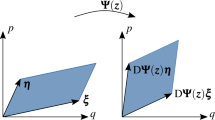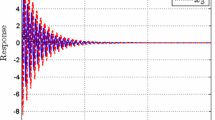Abstract
For a canonical form of mechanical systems defined through gradients of potential energy and dissipative terms, the conditions of finite-time and fixed-time (integral) input-to-state stability are derived by finding suitable Lyapunov functions. The proposed stability conditions are constructive, which is demonstrated in several applications.
Similar content being viewed by others
Notes
In this work, the abbreviation as (n)FxTS means that both properties, nFxTS and FxTS, are referenced.
References
Aleksandrov AY (2020) Stability analysis and synthesis of stabilizing controls for a class of nonlinear mechanical systems. Nonlinear Dyn 100(4):3109–3119
Aleksandrov AY, Efimov D, Dashkovskiy S (2022) On strict Iss-Lyapunov functions for mechanical systems. Int J Robust Nonlinear Control
Aleksandrov AY, Kosov AA (2010) The stability and stabilization of non-linear, non-stationary mechanical systems. J Appl Math Mech 74(5):553–562
Andrieu V, Praly L, Astolfi A (2008) Homogeneous approximation, recursive observer design, and output feedback. SIAM J Control Optim 47(4):1814–1850
Angeli D, Sontag ED, Wang Y (2000) A characterization of integral input-to-state stability. IEEE Trans Automat Control 45(6):1082–1097
Bacciotti A, Rosier L (2001) Liapunov functions and stability in control theory, vol 267. Lecture notes in control and information science. Springer, Berlin
Beletsky VV (1966) Motion of an artificial satellite about its center of mass. Israel Program for Scientific Translation, Jerusalem
Bhat SP, Bernstein DS (2000) Finite time stability of continuous autonomous systems. SIAM J Control Optim 38(3):751–766
Chaillet A, Angeli D, Ito H (2012) Strong iISS: combination of iISS and ISS with respect to small inputs. In: 2012 IEEE 51st IEEE conference on decision and control (CDC), pp 2256–2261
Cortes J, Martinez S, Karatas T, Bullo F (2004) Coverage control for mobile sensing networks. IEEE Trans Robot Autom 20(2):243–255
Cruz-Zavala E, Sanchez T, Moreno JA, Nuno E (2018) Strict Lyapunov functions for homogeneous finite-time second-order systems. In: 2018 IEEE conference on decision and control (CDC), pp 1530–1535
Dashkovskiy S (2019) Practical examples of ISS systems. IFAC Pap 52(16):1–6
Dashkovskiy SN, Efimov DV, Sontag ED (2011) Input to state stability and allied system properties. Autom Remote Control 72(8):1579–1614
Du HB, Li SH (2012) Finite-time attitude stabilization for aspacecraft using homogeneous method. J Guid Control Dyn 35(3):740–748
Efimov D, Aleksandrov A (2021) Analysis of robustness of homogeneous systems with time delays using Lyapunov–Krasovskii functionals. Int J Robust Nonlinear Control 31:3730–3746
Efimov D, Polyakov A (2021) Finite-time stability tools for control and estimation. Found Trends Syst Control 9(2–3):171–364
Giri DK, Sinha M (2014) Magneto-coulombic attitude control of earth-pointing satellites. J Guid Control Dyn 37(6):1946–1960
Holloway J, Krstic M (2019) Prescribed-time output feedback for linear systems in controllable canonical form. Automatica 107:77–85
Hong Y, Jiang Z, Feng G (2010) Finite-time input-to-state stability and applications to finite-time control design. SIAM J Control Optim 48(7):4395–4418
Huang X, Lin W, Yang B (2005) Global finite-time stabilization of a class of uncertain nonlinear systems. Automatica 41(5):881–888
Khalil HK (2002) Nonlinear systems. Prentice-Hall, Upper Saddle River
Lageman C, Helmke U, Anderson BDO (2015) Formation control on lines, circles and ellipses: genericity results and Morse theoretic ideas. In: 2015 54th IEEE conference on decision and control (CDC), pp 4278–4283
Leonard NE, Olshevsky A (2013) Nonuniform coverage control on the line. IEEE Trans Automat Control 58(11):2743–2755
Lin Y, Sontag ED, Wang Y (1996) A smooth converse Lyapunov theorem for robust stability. SIAM J Control Optim 34(1):124–160
Lopez-Ramirez F, Efimov D, Polyakov A, Perruquetti W (2019) Conditions for fixed-time stability and stabilization of continuous autonomous systems. Syst Control Lett 129:26–35
Lopez-Ramirez F, Efimov D, Polyakov A, Perruquetti W (2020) Finite-time and fixed-time input-to-state stability: explicit and implicit approaches. Syst Control Lett 130
Malisoff M, Mazenc F (2009) Constructions of strict Lyapunov functions. Springer, London
Moulay E, Perruquetti W (2006) Finite time stability and stabilization of a class of continuous systems. J Math Anal Appl 323(2):1430–1443
Moulay E, Perruquetti W (2008) Finite time stability conditions for non autonomous continuous systems. Int J Control 81(5):797–803
Nersesov SG, Haddad WM, Hui Q (2008) Finite-time stabilization of nonlinear dynamical systems via control vector Lyapunov functions. J Franklin Inst 345:819–837
Parsegov S, Polyakov A, Shcherbakov P (2012) Nonlinear fixed-time control protocol for uniform allocation of agents on a segment. In: Proceedings of 51st IEEE conference on decision and control (CDC), pp 7732–7737
Polyakov A (2012) Nonlinear feedback design for fixed-time stabilization of linear control systems. IEEE Trans Autom Control 57(8):2106–2110
Qian C, Lin W (2001) A continuous feedback approach to global strong stabilization of nonlinear systems. IEEE Trans Autom Control 46(7):1061–1079
Roxin E (1966) On finite stability in control systems. Rendiconti del Circolo Matematico di Palermo 15:273–283
Shen Y, Xia X (2008) Semi-global finite-time observers for nonlinear systems. Automatica 44(12):3152–3156
Sontag ED (2007) Input to state stability: basic concepts and results. In: Nistri P, Stefani G (eds) Nonlinear and optimal control theory. Springer, Berlin, pp 163–220
Terushkin M, Fridman E (2021) Network-based deployment of nonlinear multi agents over open curves: a PDE approach. Automatica 129:109697
Wagner IA, Bruckstein AM (1997) Row straightening via local interactions. Circuits Syst Signal Process 16:287–305
Zavala-Río A, Sanchez T, Zamora-Gómez GI (2022) On the continuous finite-time stabilization of the double integrator. SIAM J Control Optim 60(2):699–719
Zhao Z-L, Jiang Z-P, Liu T, Chai T (2021) Global finite-time output-feedback stabilization of nonlinear systems under relaxed conditions. IEEE Trans Autom Control 66(9):4259–4266
Zimenko K, Polyakov A, Efimov D, Kremlev A (2022) Homogeneity based finite/fixed-time observers for linear mimo systems. Int J Robust Nonlinear Control
Zimenko K, Polyakov A, Efimov D, Perruquetti W (2020) Robust feedback stabilization of linear mimo systems using generalized homogenization. IEEE Trans Autom Control 65(12):5429–5436
Zubov VI (1975) Lectures on control theory. Nauka, Moscow (Russian)
Author information
Authors and Affiliations
Corresponding author
Additional information
Publisher's Note
Springer Nature remains neutral with regard to jurisdictional claims in published maps and institutional affiliations.
The paper is partly supported by the Ministry of Science and Higher Education of Russian Federation, passport of Goszadanie No. 2019-0898. Section 5 was performed in IPME RAS and supported by the Ministry of Science and Higher Education of the Russian Federation under Project 075-15-2021-573.
Rights and permissions
Springer Nature or its licensor (e.g. a society or other partner) holds exclusive rights to this article under a publishing agreement with the author(s) or other rightsholder(s); author self-archiving of the accepted manuscript version of this article is solely governed by the terms of such publishing agreement and applicable law.
About this article
Cite this article
Aleksandrov, A., Efimov, D. & Dashkovskiy, S. Design of finite-/fixed-time ISS-Lyapunov functions for mechanical systems. Math. Control Signals Syst. 35, 215–235 (2023). https://doi.org/10.1007/s00498-022-00338-x
Received:
Accepted:
Published:
Issue Date:
DOI: https://doi.org/10.1007/s00498-022-00338-x




